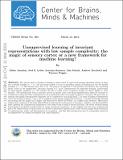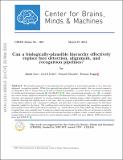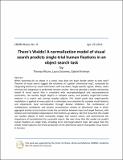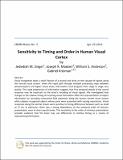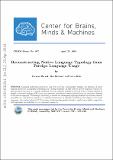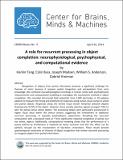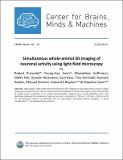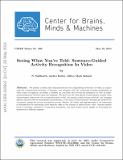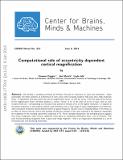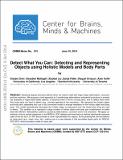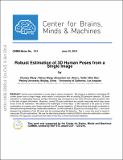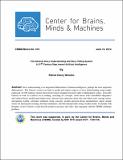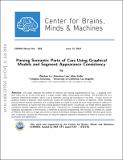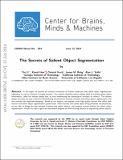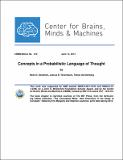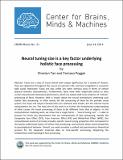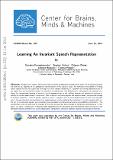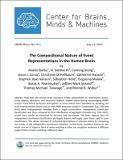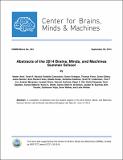Browsing CBMM Memo Series by Issue Date
Now showing items 1-20 of 141
-
Unsupervised learning of invariant representations with low sample complexity: the magic of sensory cortex or a new framework for machine learning?
(Center for Brains, Minds and Machines (CBMM), arXiv, 2014-03-12)The present phase of Machine Learning is characterized by supervised learning algorithms relying on large sets of labeled examples (n → ∞). The next phase is likely to focus on algorithms capable of learning from very few ... -
Can a biologically-plausible hierarchy e ectively replace face detection, alignment, and recognition pipelines?
(Center for Brains, Minds and Machines (CBMM), arXiv, 2014-03-27)The standard approach to unconstrained face recognition in natural photographs is via a detection, alignment, recognition pipeline. While that approach has achieved impressive results, there are several reasons to be ... -
A normalization model of visual search predicts single trial human fixations in an object search task.
(Center for Brains, Minds and Machines (CBMM), arXiv, 2014-04-25)When searching for an object in a scene, how does the brain decide where to look next? Theories of visual search suggest the existence of a global attentional map, computed by integrating bottom-up visual information with ... -
Sensitivity to Timing and Order in Human Visual Cortex.
(Center for Brains, Minds and Machines (CBMM), arXiv, 2014-04-25)Visual recognition takes a small fraction of a second and relies on the cascade of signals along the ventral visual stream. Given the rapid path through multiple processing steps between photoreceptors and higher visual ... -
Reconstructing Native Language Typology from Foreign Language Usage
(Center for Brains, Minds and Machines (CBMM), arXiv, 2014-04-25)Linguists and psychologists have long been studying cross-linguistic transfer, the influence of native language properties on linguistic performance in a foreign language. In this work we provide empirical evidence for ... -
A role for recurrent processing in object completion: neurophysiological, psychophysical and computational evidence.
(Center for Brains, Minds and Machines (CBMM), arXiv, 2014-04-26)Recognition of objects from partial information presents a significant challenge for theories of vision because it requires spatial integration and extrapolation from prior knowledge. We combined neurophysiological recordings ... -
Simultaneous whole‐animal 3D imaging of neuronal activity using light‐field microscopy
(Center for Brains, Minds and Machines (CBMM), 2014-05-18)High-speed, large-scale three-dimensional (3D) imaging of neuronal activity poses a major challenge in neuroscience. Here we demonstrate simultaneous functional imaging of neuronal activity at single-neuron resolution in ... -
Seeing What You’re Told: Sentence-Guided Activity Recognition In Video
(Center for Brains, Minds and Machines (CBMM), arXiv, 2014-05-29)We present a system that demonstrates how the compositional structure of events, in concert with the compositional structure of language, can interplay with the underlying focusing mechanisms in video action recognition, ... -
Computational role of eccentricity dependent cortical magnification
(Center for Brains, Minds and Machines (CBMM), arXiv, 2014-06-06)We develop a sampling extension of M-theory focused on invariance to scale and translation. Quite surprisingly, the theory predicts an architecture of early vision with increasing receptive field sizes and a high resolution ... -
Detect What You Can: Detecting and Representing Objects using Holistic Models and Body Parts
(Center for Brains, Minds and Machines (CBMM), arXiv, 2014-06-10)Detecting objects becomes difficult when we need to deal with large shape deformation, occlusion and low resolution. We propose a novel approach to i) handle large deformations and partial occlusions in animals (as examples ... -
Robust Estimation of 3D Human Poses from a Single Image
(Center for Brains, Minds and Machines (CBMM), arXiv, 2014-06-10)Human pose estimation is a key step to action recognition. We propose a method of estimating 3D human poses from a single image, which works in conjunction with an existing 2D pose/joint detector. 3D pose estimation is ... -
The Genesis Story Understanding and Story Telling System A 21st Century Step toward Artificial Intelligence
(Center for Brains, Minds and Machines (CBMM), 2014-06-10)Story understanding is an important differentiator of human intelligence, perhaps the most important differentiator. The Genesis system was built to model and explore aspects of story understanding using simply expressed, ... -
Parsing Semantic Parts of Cars Using Graphical Models and Segment Appearance Consistency
(Center for Brains, Minds and Machines (CBMM), arXiv, 2014-06-13)This paper addresses the problem of semantic part parsing (segmentation) of cars, i.e.assigning every pixel within the car to one of the parts (e.g.body, window, lights, license plates and wheels). We formulate this as a ... -
The Secrets of Salient Object Segmentation
(Center for Brains, Minds and Machines (CBMM), arXiv, 2014-06-13)In this paper we provide an extensive evaluation of fixation prediction and salient object segmentation algorithms as well as statistics of major datasets. Our analysis identifies serious design flaws of existing salient ... -
Concepts in a Probabilistic Language of Thought
(Center for Brains, Minds and Machines (CBMM), 2014-06-14)Knowledge organizes our understanding of the world, determining what we expect given what we have already seen. Our predictive representations have two key properties: they are productive, and they are graded. Productive ... -
Neural tuning size is a key factor underlying holistic face processing
(Center for Brains, Minds and Machines (CBMM), arXiv, 2014-06-14)Faces are a class of visual stimuli with unique significance, for a variety of reasons. They are ubiquitous throughout the course of a person’s life, and face recognition is crucial for daily social interaction. Faces are ... -
Human-Machine CRFs for Identifying Bottlenecks in Holistic Scene Understanding
(Center for Brains, Minds and Machines (CBMM), arXiv, 2014-06-15)Recent trends in image understanding have pushed for holistic scene understanding models that jointly reason about various tasks such as object detection, scene recognition, shape analysis, contextual reasoning, and local ... -
Learning An Invariant Speech Representation
(Center for Brains, Minds and Machines (CBMM), arXiv, 2014-06-15)Recognition of speech, and in particular the ability to generalize and learn from small sets of labelled examples like humans do, depends on an appropriate representation of the acoustic input. We formulate the problem of ... -
The Compositional Nature of Event Representations in the Human Brain
(Center for Brains, Minds and Machines (CBMM), arXiv, 2014-07-14)How does the human brain represent simple compositions of constituents: actors, verbs, objects, directions, and locations? Subjects viewed videos during neuroimaging (fMRI) sessions from which sentential descriptions of ... -
Abstracts of the 2014 Brains, Minds, and Machines Summer School
(Center for Brains, Minds and Machines (CBMM), 2014-09-26)A compilation of abstracts from the student projects of the 2014 Brains, Minds, and Machines Summer School, held at Woods Hole Marine Biological Lab, May 29 - June 12, 2014.

